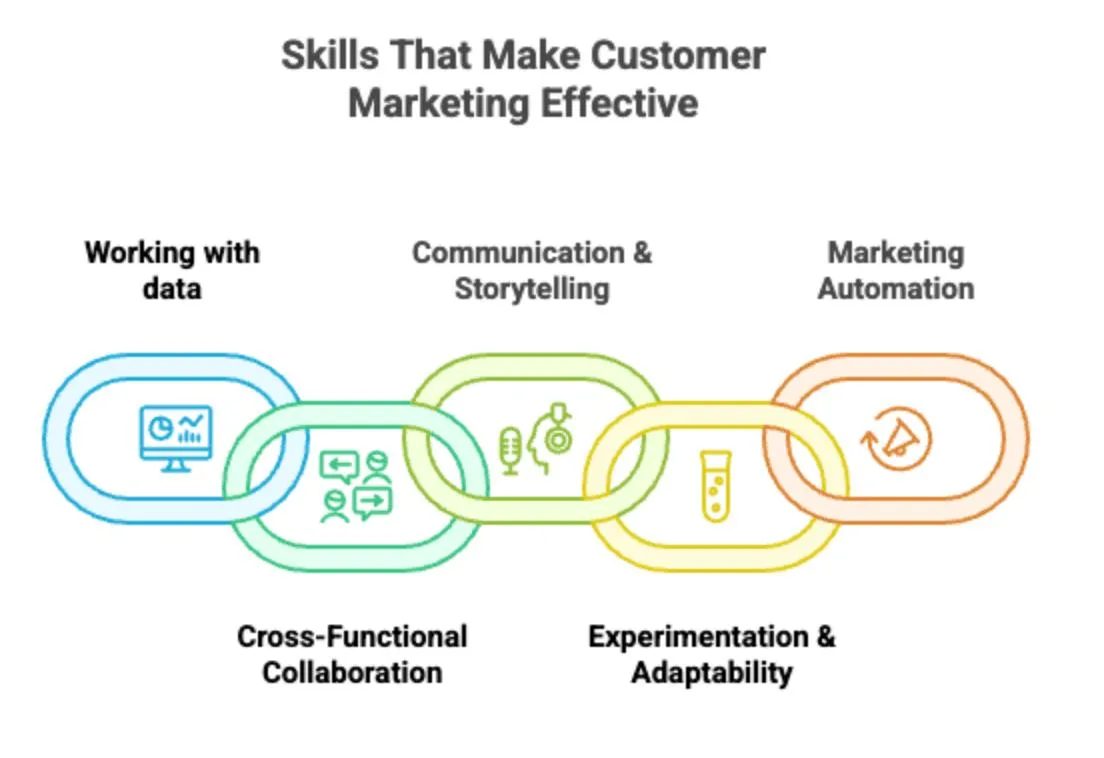Customer Marketing Manager: The Role Powering Retention and Advocacy in B2B
Winning a customer is only the beginning. The real growth comes from keeping that customer engaged, helping them succeed, and turning them into an advocate who tells the world about it. That’s where customer marketing comes in. It’s the discipline that fuels retention, expansion, and long-term loyalty, making it one of the most important roles in today’s go-to-market (GTM) teams.
What is Customer Marketing?
Customer marketing focuses on strengthening the relationship between customers and the business after the initial sale. It’s about creating programs that drive adoption, retention, and expansion while also building advocacy that fuels referrals and brand credibility.
The work spans a wide range of initiatives: campaigns that keep customers engaged, programs that identify upsell opportunities, and advocacy efforts that highlight customer success stories. At its core, customer marketing ensures customers achieve maximum value and that value translates back into measurable revenue impact.
How the Role Has Evolved
Not long ago, customer marketing was seen as a secondary function mainly tasked with newsletters, customer updates, or collecting testimonials. Acquisition was the primary growth lever, and retention was often left to customer success teams.
That’s changed. Rising acquisition costs, more competitive markets, and the subscription economy have made retention and expansion just as critical as acquisition. Customer marketing has shifted from a supportive communication role to a strategic growth driver. It is now measured on outcomes like Net Revenue Retention (NRR), churn reduction, upsell and cross-sell revenue, and advocacy influence on pipeline.
What the Role Looks Like in Practice
A Customer Marketing Manager today designs and executes programs that touch every part of the customer lifecycle.
Driving Engagement and Retention
They run ongoing initiatives like newsletters, webinars, user groups, loyalty programs–often powered by marketing automation to keep customers informed, active, and connected. These programs are designed not just for touchpoints, but for reducing churn and deepening adoption.
Supporting Expansion
By analyzing product usage and customer feedback, they identify moments where upsell or cross-sell can add value. Working with customer success, they create targeted campaigns to capture that growth.
Building Advocacy
Customer marketing turns success stories into case studies, testimonials, and referrals that amplify credibility, accelerate sales cycles, and contribute directly to pipeline growth.
Using Data to Drive Action
Metrics like NRR, churn rate, and adoption trends guide every initiative. Customer marketers translate this data into programs that directly impact revenue and customer health.
Communicating Product Value
Each product release is an opportunity to drive deeper product adoption. Customer marketers design product adoption campaigns that make new features clear, useful, and exciting, ensuring customers see immediate value and long-term benefits.
Skills That Make Customer Marketing Effective
Being a newer marketing function, customer marketing draws talent from many backgrounds like customer success, content, product marketing, operations, each adding strengths in relationships, storytelling, or data. That diversity is part of what makes it such a dynamic and fast-growing discipline. What matters most is developing a mix of skills that allow you to design and run programs that create real impact for customers and for the business.
Understanding the Customer Journey

You need to see how adoption, retention, and expansion fit together. Knowing what signals show a healthy customer versus a churn risk is a core skill.
Working With Data
Metrics like NRR, churn rate, and product usage aren’t abstract, they guide decisions. Even if you’re not an analyst, comfort with dashboards, reports, and marketing automation workflows is essential.
Communication and Storytelling
From newsletters to case studies, customer marketers spend much of their time translating insights into messages that resonate with customers and internal teams alike.
Cross-Functional Collaboration
The role sits between customer success, sales, and product. Being able to work across those teams, and turn their feedback into coordinated programs, is what makes initiatives succeed.
Experimentation and Adaptability
Customer marketing is evolving quickly, especially in PLG and AI-native companies. New tools for personalization and engagement appear constantly. A willingness to try, test, and learn is often more valuable than deep specialization in one channel.
These are the capabilities that help someone grow in customer marketing today. They’re the foundation whether you’re starting out in the field or aiming to build toward leadership later.
Why Customer Marketing Is Core to Growth
Customer marketing has earned its place alongside demand generation and marketing operations as a core driver of growth. It ensures that marketing’s impact doesn’t end at acquisition but continues through retention, expansion, and advocacy.
For organizations, investing in this role means stronger NRR, healthier customer relationships, and more efficient growth. For professionals, it’s a career path at the center of how modern B2B companies scale. At Inflection, we believe customer marketing is one of the most important roles in GTM today. With the right tools and data, customer marketers can deepen relationships, build communities of advocates, and directly contribute to sustainable revenue growth.
Inflection helps B2B and AI-native companies drive pipeline and growth across the account lifecycle. By unifying data through the ContextGraph, Inflection powers demand generation, onboarding, and expansion with the intelligence and automation teams need to deliver measurable impact. Request a demo today.
%201.webp)





